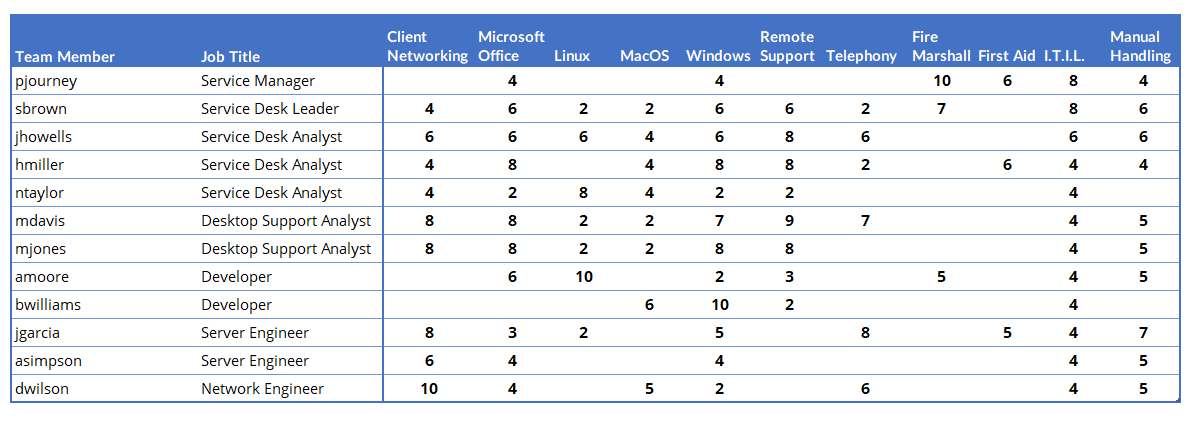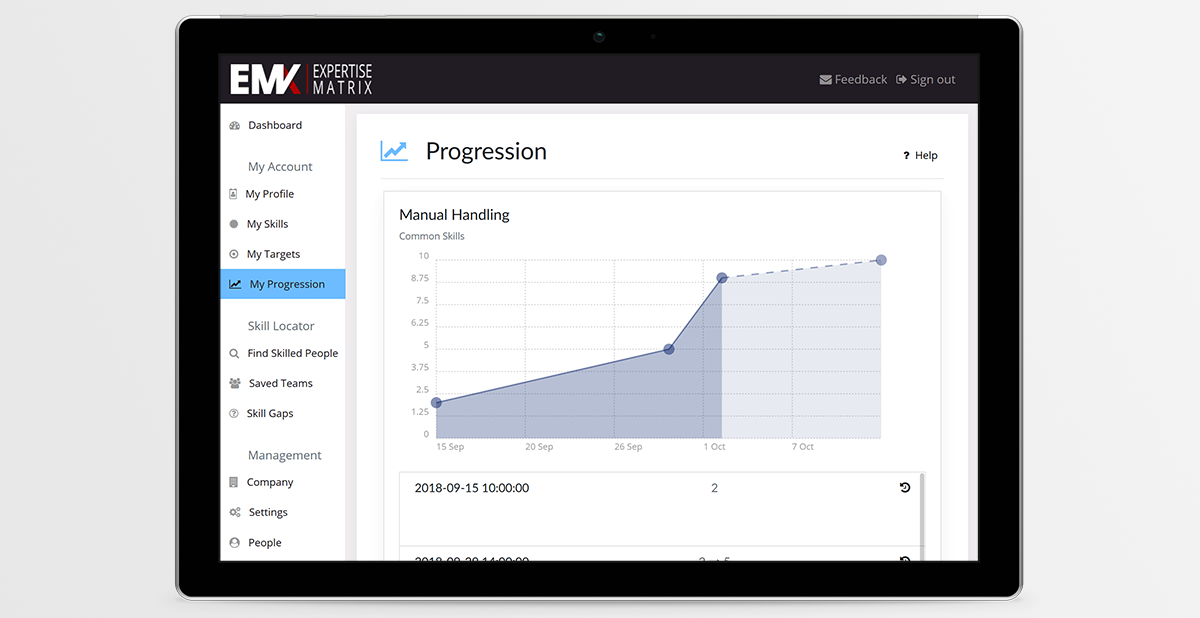
21st Century Skill Mapping
Taking a modern approach to your team’s skill management
The day of the specialist is ending, more than ever we are asking for our team members to broaden their skill bases, to incorporate more systems and processes into their daily routines. The age of the Johannes factotum is dawning.
The old adage goes “Jack of all trades, master of none“, but in this modern world we still need and ask for people to become masters. So is it possible, if you’ll forgive another aphorism, to have our cake and eat it?
In this article I aim to look at the shift away from specialists in many industries, what has replaced them, and how we need to adapt our processes when managing this new workforce. It is written from my own viewpoint as an expert in the IT industry, but I hope that many of its points can be applied to teams of different disciplines and industries.
The Move Away from Specialists
Back when I started out in the IT industry *cough-mumble-ty* years ago, it was heavily populated by specialists. In my experience this was because of the relatively small number of technologies that were around at the time. You were a UNIX expert, or a COBOL guru, or a Java master, and so on. Sure, you’d still have a range of other skills, but there’d usually be one core thing you were really known for.
Today the skills that an individual needs to know in even a small single-stack team are significantly more diverse. Where once landing a job as a PHP developer required little more than expertise in PHP, now many job seekers are asked for PHP, JQuery, Apache, AWS, at least one relevant database, Node.js, Angular, how to make a proper cup of tea, etc.
I’ve seen many developers lament this change in job requirements. But the fact of the matter is that employers don’t belligerently create unrealistic demands, they’re just responding to a rapidly changing environment where past, present and future technologies must be considered; and legacy, current and pipelined products must be supported.
Managing Skills

With this diversification and refined delineation of skill sets comes the inevitable problem of managing them. When you’re in an industry that routinely has to reference information about 5 or 10 years’ worth of systems and processes, keeping track of who knows what can seem insurmountable at times.
We’ve all been there, you come in to work one day and somebody has made a request for information on Process P. But it’s been at least a year or more since anyone asked about it last, and you can’t quite remember who dealt with it last time. You ask around and, oh yes, it was this one particular employee… but they’re on training this week. Does anybody else know?
In this scenario, I should immediately have been able to identify who is the owner of Process P, and, if they are unavailable, a list of other people who have sufficient working knowledge of the process to take temporary responsibility for it.
While in this case, a simple request for information, time may not be the leading factor. This can easily apply to a mission-critical process or system in which time is a luxury that cannot be afforded. Can you say with 100% confidence that you would be identify that person/those people quickly and efficiently?
The popular solution among many of the teams I’ve worked for and with, of course, is the classic Skill Matrix.
What are Skill Matrices?

The typical example you will likely have seen is a sheet of paper with a list of your team member’s names down one side and a list of skills, systems or processes along the other axis.

Either you as a manager, or the persons in question, enter a value from a pre-defined range (often 1 to 3, or 1 to 10, where blank is no skill, 1 is a basic awareness and 10 is a high level of knowledge and/or experience) for each skill. This value is then supposed to represent their expertise (hence my preference for the term “Expertise Matrix“) in that skill.
These are a classic management tool, and can provide a great snapshot into the skills your team member’s possess, and an excellent starting point when you need to find someone with a particular set of skills.
Problems with the Skill Matrix
The Skill/Expertise Matrix features a few fundamental problems though:
1. People are subconsciously biased

In social psychology there is a condition known as illusory superiority,
which is where people overestimate their abilities in relation to the
same abilities in other people. On the other end of the scale, of
course, is illusory inferiority.
This is a problem when you’re
getting people to place their skills on a range, their only real point
of reference is going to be other people they know with that skill, and
depending on their personality this could negatively impact on them by
making them either overestimate or underestimate their own expertise.
2. People are consciously biased

When carrying out an expertise matrix exercise some years ago, I noticed
that one or two skills were dangerously under-represented. It seems
like people were unwilling to say they had any knowledge of the system
in question, or, if they did, that they only know a tiny amount about
it.
It turns out that these systems were old, unreliable and
universally disliked. So naturally, people were disavowing any knowledge
of them in the hope that they wouldn’t be called upon to do anything
with them.
3. Skill Matrices are Static

While I’ve seen a few places that make a point to refresh their matrices every year, the results are largely static, and get outdated before you’ve even finished collating the results. They provide some insight, but as people come and go, and as they develop new skills, the matrix falls quickly be the side.
Moving to the 21st Century

Process Fluidity
So what is needed to bring a Skill or Expertise Matrix into the now? Simply put it cannot be an exercise, it can’t be something you pick up once a year to update. Your skill management process needs to be as fluid, as adaptable and as responsive as your team members are, and it is critical that your Expertise Matrix or Matrices are never treated as a static document.
I like to use the C.R.U.D. acronym from computer programming to explain this:
– Create
This happens when a new skill, process or system is introduced into your sphere of influence, and it is added to your Expertise Matrix.
– Read
Review the information in your Matrix, check for skill gaps or over-subscribed skills. Use this information to define targets for your team.
– Update
If somebody completes some training or gains extra experience in a skill, they should be able to update the matrix so that it is immediately reflective of their competency.
– Delete
Similarly, if someone changes role and is no longer responsible for anything involving a particular skill, they should be able to reduce it as time goes on as they lose that experience. When a skill is no longer required, it should be removed from the matrix.
That’s not to say that the yearly update should be thrown out, indeed it may be that one of the only ways to truly combat skill bias is through a regular review process where you’re able to discuss why somebody put a particular value, and see if they’d be open to changing it. This could be done as part of a standard Personal/Professional Development Review process.
Making the Expertise Matrix a Force for Change
More than reporting, more than as a reference tool, the Expertise Matrix should be embraced as a force for change. Once developed and implemented well, you can effectively use it to:
Drive professional development

Identify strengths and weaknesses in your team members, work with them to see what new skills they’d like to pick up, or the existing ones they would like to develop. Use this information to set targets with realistic goals and deadlines, and record this in your matrix so that they can gain positive feedback by seeing a visual representation of how far they’ve come.
Identify areas at risk

If you have a critical process or system with nobody or only a minimal number of people capable enough to deal with a disaster, then that system is at-risk, and your matrix will show this. Use this information to plan future training and build in redundancy to avoid single-points-of-failure.
Planned obsolescence

Your matrix may show that very few people have knowledge of a process or system. While this may still be required as mentioned above, it may also be that it’s falling out of the knowledge pool because nobody needs it anymore. This can be really useful information to help plan for service retirement.
Digital Solutions for a Digital Age

Now that you’ve had the time to consider the benefits of a fluid, well maintained skill matrix, you need to think about how best to implement this knowledge.
Throw out that paper Skill Matrix template that you photocopy and fill out in pencil every year. The technology is out there, and it can prove invaluable to small and large teams alike because they take the hard work out of building and managing a skill matrix.
Try out an online solution like ExpertiseMatrix.com, and take advantage of great features such as target tracking and historical skill analysis. Systems like this allow complete management of the matrix by your managers, or the ability to add your team members so they can manage their own skills.
They tend to be inexpensive, and the productivity and personal development gains make them pay for themselves.
Like the article? Share with your friends:
 Int64 Software Ltd
Int64 Software Ltd